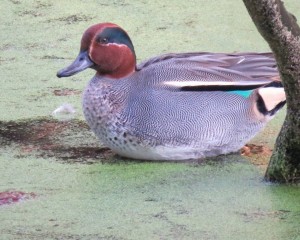
The November WeBS count for the British Trust for Ornithology is usually an interesting one, with wildfowl numbers building up as the UK benefits from influxes of dabbling and diving ducks from continental Europe. It was hard to believe the date was 9 November as we walked around Wanstead Park’s lakes and ponds in glorious sunshine and with a temperature rising to at least 13 degrees. So warm was it, in fact, that a Red Admiral and ovipositing dragonflies were noted. Following our tried and tested route, around the Shoulder of Mutton pond and Heronry Lake, we noted increased Coot numbers since the October count, and a total of 17 Pochard and 16 Mute Swans on Heronry. There were a few Shoveler, Gadwall and Tufted Duck on Perch, and 87 Gadwall and nine Common Teal were counted on the Ornamental Waters. Some of the biggest surprises were on The Basin, where a count of 12 Egyptian Geese represents the biggest number ever noted on a local WeBS count. However, Tom the water bailiff estimated that there had been up to 30 in the previous week. Where has this influx come from? There were another 46 Gadwall on The Basin, along with four Wigeon. The third of the day’s Kingfishers was at the Overton Drive end of the lake. Overall, in addition to the noteworthy counts of Gadwall and Egyptian Geese, the totals for Coot and Moorhen were also high.
Thanks to Nick Croft, David Giddings, Kathy Hartnett, Jackie Morrison, Haydn Powell, and Andrew Spencer
Combined with figures for Alexandra Lake (NC, in parenthesis), today’s totals were as follows:
- Mute Swan: 27
- Greylag Goose: 14 (10)
- Canada Goose: 165 (124)
- Egyptian Goose: 12
- Eurasian Wigeon: 4
- Gadwall: 221 (28)
- Common Teal: 10 (1)
- Mallard: 118 (26)
- Shoveler: 16 (5)
- Pochard: 22 (5)
- Tufted Duck: 51 (11)
- Little Grebe: 13 (4)
- Great Crested Grebe: 4
- Cormorant: 2
- Grey Heron: 6
- Moorhen: 74 (34)
- Coot: 278 (102)
- Black-headed Gull: 74
- Common Gull: 1
- Kingfisher: 3
Tim Harris